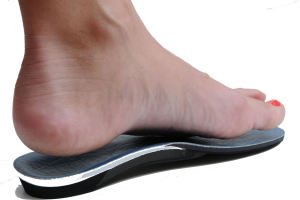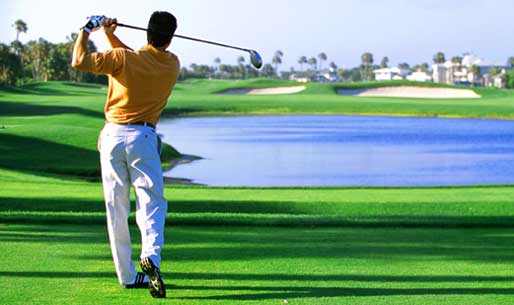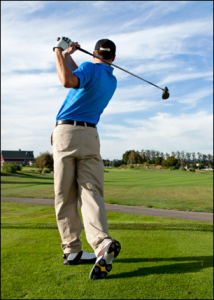The foot explained!
The foot is made up of 26 bones, ligaments, muscles and tendons. The foot functions
as one link in a biomechanical kinetic chain, where movement at one joint influences movement at other joints in the chain. Each bone in the foot performs bending, and rotational motions during the gait phase.
When the foot hits the ground, a series of events extending throughout the body is set into motion. This complex interaction of bone and soft tissue can cause or contribute to a number of conditions.
Flexible, Custom-Made Orthotics
support and encourage normal foot function, which in turn helps protect the body from the harmful effects of faulty biomechanics. When the feet provide a balanced foundation for the body, its components can work together most effectively. A house with a flawed foundation may stand for years, but problems (leaks, cracked walls or sagging windows) will eventually develop. The effects of foot imbalance on the body can be just as insidious.

Common Swing Faults
Common swing faults occur due to tight shoulder, tightness in the hip joint, spinal injuries, and repetitive strain injuries. When shoulder rotation is restricted the body compensates with excessive spinal rotation. This can result in back injury because most people already lack flexibility in the spine.
In addition, golfers will notice that they have difficulties in:
- Keeping their eyes on the ball.
- Maintaining an optimal swing plane.
This results in fat or thin shots. When the golfer attempts to compensate at the shoulder joint, the chances of a hook or slice increases. Tightness in the hip joint rotational muscles places additional strain on the rotational requirements of the shoulder or spine. Often a golfer will compensate by lifting up during the back swing and then chop down on the ball resulting in a flat shot.
Wrist and elbow injuries often occur when the body does not have the capacity to effectively compensate at either the shoulder or spine. The wrists are then over-used to drive as well as decelerate the golf club.
Stretching Will Not Break The Adhesions
Even individuals such as professional athletes who are constantly stretching find it difficult to release these soft tissue adhesions. This is why so many professional and amateur athletes are turning to Active Release Technique (ART) to release and remove these restrictions.
Scar tissue (or soft tissue adhesions) is several times stronger than normal tissue. Often muscle groups will literally adhere to each other, preventing the sliding necessary for full mobility. During normal stretching, the first tissue that elongates is not the scar tissue, but the normal healthy tissue. Stretching is essential at the right time, but it never releases the restrictions that often occur between two soft tissue surfaces.
________________________________________________________________________
Your golf swing is all about proper body mechanics. A good golf swing requires full rotational capacity of nearly every joint involved and must be done – efficiently – easily – explosively – repeatedly. Many swing faults are directly attributable to poor joint mobility with soft-tissue restrictions.
In order to effectively balance your muscles and remove joint restrictions we must first identify your unique pattern of muscle imbalances. By utilizing a series of muscle balance and swing analysis tests, we can identify the exact type, extent, and location of muscle restriction.
Is it time to have it checked?
______________________________
Most Common Injuries for the PGA Tour:
1. Low back pain (25%)
2. Left wrist (16.1%)
3. Left shoulder (10.9%)
4. Left knee (7%)
5. Left hand (6.8%)
Many people stop playing golf because of injury. Interestingly, golfers will spend hundreds of dollars each year on new or improved equipment but will not invest any time or money in the most essential piece of equipment— their body.
Do you think within your body you have stiffness that is limiting your golf swing?
The most common injuries in golf are back injuries. Most of these injuries are muscle, ligament or joint strains that can be treated effectively if caught early. Changing technique and equipment can help golfers with chronic (long-term) back pain play around with the injury – it will not help correct the problem though. Constant bending over and rotational motions cause extreme stress on the muscles and joints of the lower back. The use of newer and longer clubs can allow your body to remain closer to the upright position and help relieve stress on your back.
Shoulder problems are often due to improper mechanics between the shoulder, lower neck area, mid-back and the shoulder blades. This is known as SCAPULO-THORACIC Motion. If a limitation of motion in this area, then the GLENO-HUMERAL (Shoulder) Joint will have to compensate. If compensation occurs at the shoulder joint, the chances of hooking or slicing the ball increase exponentially. Restricted shoulder range of motion is compensated with excessive spinal rotation, leading to back injury because most golfers lack rotational flexibility in the spine to begin with.
Golfer’s elbow is an inflammation of the tendons which allow the elbow to flex (bend). Treatment consists of ice, rest, adjustments, soft tissue therapy (Active release technique/massage therapy), wearing a brace and stretching.



